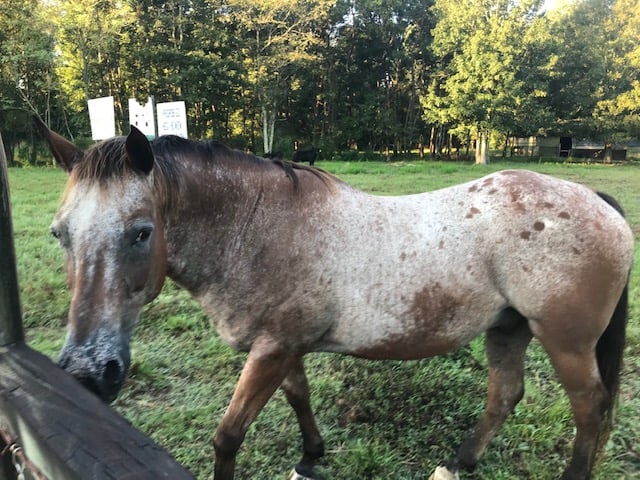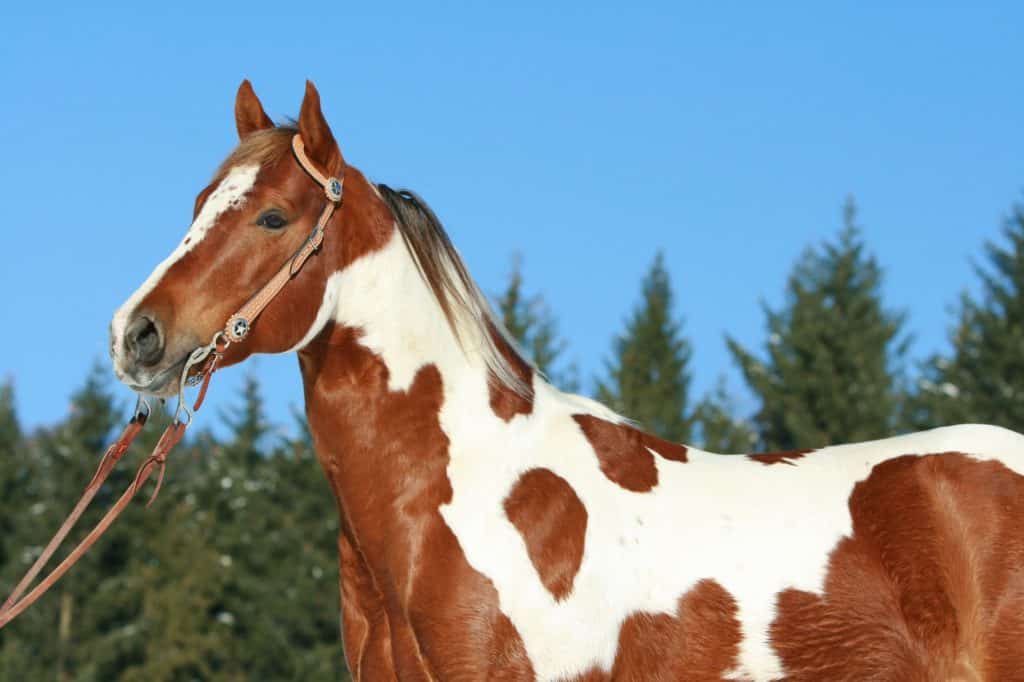Last updated: March 13, 2024
Have you ever seen a horse with spots and wondered what breed it is? In ‘What Horses Have Spots?’ we will examine the different kinds of spotted horses. From the well-known Appaloosa with its unique patterns to the less common Knabstrupper, we’ll explore what makes these horses stand out.
We’ll discuss their history, what sets them apart, and why those spots aren’t just cool to look at but have stories behind them. Let’s explore the world of spotted horses and discover what makes them special.
Horse Breeds with Spots
When discussing horses with spots, a few breeds immediately jump to the forefront. These breeds aren’t just known for their distinctive coat patterns; they also come with rich histories and unique characteristics that make them stand out. Let’s take a closer look at some of these spotted wonders:
Appaloosa

The Appaloosa is likely the breed that springs to mind when thinking of spotted horses. Renowned for their distinctive leopard-spotted coat, these horses boast more than their stunning appearance. With traits like a white blanket across their hindquarters and striped hooves, Appaloosa horses carry a unique beauty.
Originating from the Nez Perce Native American tribe, they are known for their agility, endurance, and friendly nature. These qualities make them excellent companions for riders of all levels and embody a blend of aesthetic appeal and versatile performance.
An interesting historical note is that these horses were raised along the Palouse River, which flows through the territory of the Nez Perce. Over time, the settlers began referring to them as “A Palouse Horse,” a name that eventually evolved into “Appaloosa.”
Knabstrupper

Hailing from Denmark, the Knabstrupper is another breed that boasts an eye-catching spotted coat. Similar to the Appaloosa in appearance, Knabstruppers are known for their calm demeanor and intelligence. These horses are not just show ponies; they excel in dressage and jumping, thanks to their powerful build and keen mind.
British Spotted Pony

Lesser-known but equally charming, the British Spotted Pony is a small breed with a big personality. Cave paintings show that these ponies have existed since prehistoric times.
Despite their size, they’re hardy and adaptable, suited for children and adults. Their spots range from leopard-complex patterns to more subtle speckles, making each pony unique.
Pony of the Americas

The Pony of the Americas is a breed specifically developed to create a spotted pony suitable for children and teenagers. Starting in the 1950s with a cross between an Appaloosa and a Shetland Pony, the breed has evolved to include Arabian, Mustang, and Quarter Horse bloodlines, enhancing its versatility and performance.
With their Appaloosa-like spotting, POAs are not only striking in appearance but also excel in various equestrian disciplines, making them a favorite among young riders looking for a competitive edge.

Nez Perce Horse
The original horses bred by the Nez Perce, which included the ancestors of today’s Appaloosa, were known for their spotted coats, stamina, and versatility. The Nez Perce were highly skilled horse breeders and developed their horses to be efficient hunters, transporters, and warriors.
The modern Nez Perce Horse project, initiated in the 1990s, sought to enhance these traditional qualities by introducing Akhal-Teke bloodlines. It aimed for a horse with the endurance and speed of the Akhal-Teke and the distinctive spotted coat and hardiness of the Appaloosa.
Colorado Ranger
The Colorado Ranger is often associated with the American West, where it served as a reliable mount for ranchers. This breed can trace its lineage to two stallions imported from Turkey, which explains their distinctive spotted coats.
Colorado Rangers are not just about looks; they’re known for their stamina, intelligence, and versatility in working, events, and trail riding.

The Genetics of Spotted Patterns
Spotted coats in horses aren’t just about luck; they’re written in the horse’s DNA. The main player here is the LP gene, or Leopard Complex gene, which is responsible for those eye-catching patterns. This gene can create various looks, from full leopard spots covering the body to minimal white flecks known as snowflakes.
Another gene, PATN1, determines how these spots will spread or cluster. Understanding these genetics helps breeders and enthusiasts predict and appreciate the variety of patterns in spotted horses.
Buckskin and dun, with their distinctive dilution genes, offer a fascinating backdrop for spots, enhancing the visual complexity of breeds like the Appaloosa and Tiger Horse. These colors, along with the solid reliability of bay and the vibrant hue of chestnut, underscore the genetic richness that makes spotted horses not only a marvel to behold but also a testament to the intricate world of equine genetics.
Below is a YouTube video of a spotted Tennessee Walking Horse
Historical Significance of Spotted Horses
Spotted horses have a rich history that spans across continents and cultures, leaving an indelible mark on human civilization. The earliest evidence of their existence can be traced back to ancient cave paintings in Europe, where horses with distinctive spots are depicted, highlighting their importance to early humans.
The arrival of Spanish horses in the Americas marked a pivotal moment in the evolution of equine coat patterns. Known for their resilience and adaptability, these horses were instrumental in introducing a variety of coat patterns, including those with spots and marble effects.
By interbreeding with local horse populations, they enriched the genetic pool, leading to the development of breeds with diverse and intricate coat patterns. Among these, the Appaloosa stands out as a prime example of the lasting influence of Spanish horses on modern horse breeds.
In North America, the Nez Perce tribe recognized the value of spotted horses not only for their aesthetic appeal but also for their practical qualities. These horses were symbols of wealth and status within the tribe, prized for their distinctive coats, stamina, and intelligence.
This historical journey from ancient cave art to the selective breeding practices of the Nez Perce tribe illustrates the enduring fascination with and significance of spotted horses. Their legacy is a testament to the deep connections between humans and horses, shaped by centuries of shared history and mutual respect.
Spotted Horses in Popular Culture
From the silver screen to children’s books, spotted horses have captured the public’s imagination. The fictional character of Pippi Longstocking’s horse, “Old Man,” is a spotted horse that many of us remember fondly.
In Western movies, spotted horses often stand out as the mounts of choice for heroes and villains, symbolizing freedom and adventure. These appearances have cemented the spotted horse’s place in popular culture as a figure of intrigue and beauty.
Caring for Spotted Horses
Caring for a spotted horse involves a bit more than regular grooming. Their unique coats can be prone to sunburn, so providing shade and applying sunscreen to light-colored areas is crucial. When it comes to grooming, using a gentle brush can help maintain their coat’s health and appearance without damaging the skin.
Regular check-ups are essential, too, as some spotted breeds are susceptible to certain genetic conditions. With proper care, these spotted beauties will thrive and proudly showcase their patterns.

Pinto Horses Have Spots.
Pinto horses are not a breed but a reference to coat colors that include spots. The genetic color patterns are tobiano, overo, and tovero. These color schemes are found on numerous breeds most notably in The American Paint horses.
There is a common confusion between pinto and paint horses. However, pinto is typically used to reference color or a color breed. The American Paint horse is a specific breed.
Other breeds that typically have pinto color patterns include Quarter horses, Arabians, Icelandic Horses, and saddlebreds.

Cave Paintings Have Depicted Spotted Horses.
In Southwest France, ancient cave paintings showcase two white horses adorned with black spots. These images indicate that spotted horses existed before domestication, challenging the previously accepted belief that they appeared around 4,000 BC.
Recent genetic research and archeological findings suggest the leopard complex spotting gene (LP) has likely existed for over 25,000 years. However, other genetic spotting phenotypes, like tobiano, emerged after horse domestication, traceable only to around 1,500 BC.
FAQs on Spotted Horses
What causes the spotted patterns in horses?
Spotted patterns in horses are the result of specific genetic markers. The most well-known gene responsible for these patterns is the LP (Leopard Complex) gene, which can create a variety of patterns, from leopard spots to snowflakes.
Are all spotted horses Appaloosas?
No, not all spotted horses are Appaloosas. While the Appaloosa is one of the most famous spotted horse breeds, other breeds like the Knabstrupper, Pony of the Americas, and Tiger Horse also exhibit spotted coats.
Can a horse be born without spots and develop them later?
Yes, some horses can be born with solid coats and develop spots as they age. This is particularly common in breeds with the LP gene, where the expression of spots can change over time.
What are some common base colors for spotted horses?
Spotted horses can have a variety of base colors, including bay, chestnut, black, buckskin, and dun. The spots can appear over any of these base colors, adding to their diversity.
How are spotted horses registered?
Spotted horses are registered with breed registries documenting their lineage, patterns, and other characteristics. For example, the Appaloosa Horse Club and the Tiger Horse Association are organizations dedicated to registering and promoting their respective breeds.
Conclusion
As we conclude our exploration of spotted horses, we’ve uncovered the genetics behind their stunning patterns, celebrated their historical significance, and acknowledged their role in popular culture alongside practical care tips. These horses are not just a feast for the eyes; they embody rich stories and traditions that captivate enthusiasts worldwide.
Now, we turn to you, our readers, to enrich this journey further. Have you encountered spotted horses up close, or do you have a particular spotted horse that holds a special place in your heart? Your experiences and stories contribute to the broader narrative of these extraordinary animals.
We invite you to share your insights and memories in the comments. Together, let’s continue to admire and preserve the legacy of spotted horses, ensuring their tales and beauty are celebrated far and wide.
Resources
For those interested in learning more about spotted horse breeds or considering joining their vibrant communities, here are some valuable resources:
- Appaloosa Horse Club: Dive into the world of the Appaloosa, a breed known for its distinctive spotted coat and versatility. Whether you’re a current owner or dreaming of one day owning an Appaloosa, the Appaloosa Horse Club offers a wealth of information and a welcoming community. Visit the Appaloosa Horse Club.
- Tiger Horse Association: Explore the Tiger Horse, a breed that combines the beauty of spots with the smoothness of gait. The Tiger Horse Association is dedicated to preserving and promoting this unique breed, offering insights into its history and characteristics. Learn more about the Tiger Horse Association.
- Shetland Pony Breeders Association: Discover the charm of the Shetland Pony, a breed that captivates with its intelligence, durability, and sometimes, spotted coats. The Shetland Pony Breeders Association provides information on breed standards, care tips, and how to get involved with these delightful ponies. Explore the Shetland Pony Breeders Association.

About the Author: Miles Henry
Lifelong Horseman | Racehorse Owner | Published Author
Miles Henry brings over 25 years of hands-on experience training and owning Thoroughbred racehorses. Raised with Quarter Horses and Appaloosas, he’s spent a lifetime learning from horses—on the track, in the barn, and in the field. Today, he runs a small but successful racing stable in Louisiana and shares real-world insights on HorseRacingSense.com, helping horse owners, fans, and bettors navigate the sport with confidence.
📚 Books: View Miles’s books on Amazon »
🎧 Podcast Guest: Animal Tales Ep. 32 |
YouTube Interview
📩 Newsletter: Sign up for racing tips and horse care advice »
🔗 Follow Miles:
Twitter |
Facebook |
YouTube


